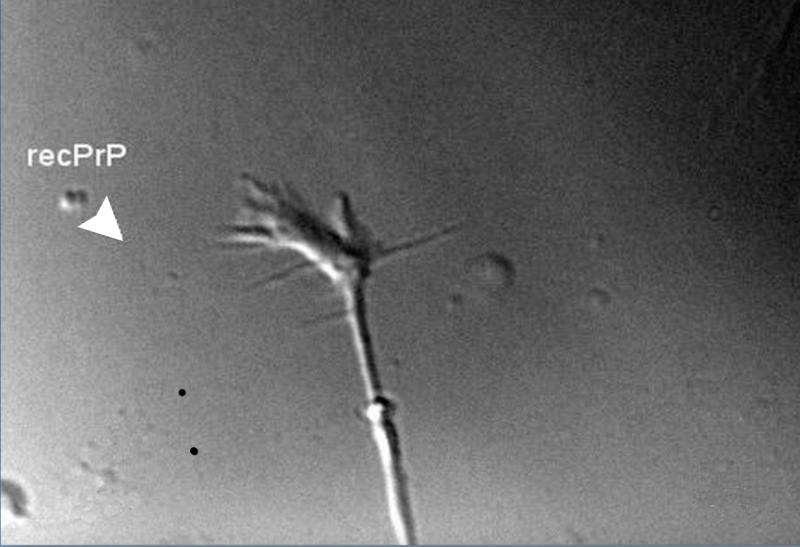Two studies describe the function of PrPc, the 'good' alter ego of prions

Two new studies coordinated by SISSA reveal important details about the physiological function of the prion protein, the non-pathological form of the notorious prion, the degenerate protein responsible for several diseases including "mad cow disease." According to the new findings, the protein in its physiological form serves the important function of promoting the growth of neurites, the neural projections along which nerve impulses travel. The two studies ideally complement each other in that one, published in the Journal of Cell Science, provides a general overview and the other, published in the Journal of Biological Chemistry, focuses on a specific stage in the process, which it describes with unprecedented completeness and detail.
The prion protein has two diametrically opposed faces: sadly notorious for its "degenerate" form that causes severe and incurable neurodegenerative diseases such as "mad cow disease" in cattle and Creutzfeldt-Jakob syndrome in humans, in its physiological form the prion protein (PrPC) serves a vital function for the brain. Its positive action had, however, never been clarified until now. Two new studies, both coordinated by Giuseppe Legname, professor at the International School for Advanced Studies (SISSA) in Trieste, finally provide a detailed description of the biochemical processes through which this protein stimulates and guides the growth of neurites, the neural membrane projections (axons and dendrites) that are all important for the conduction of nerve signals.
The first paper, an extensive and elaborate study, has just been published in the Journal of Cell Science. "In this study, carried out in collaboration with the Optical Manipulation Lab (CNR-IOM, Trieste), we used a novel technique that allowed a close-up view of the interaction between PrPC and growing neurites." The method, developed by Dan Cojoc, SISSA/CNR-IOM research scientist, involves inserting the PrP into micro-vesicles that were then placed close to the growth cones of hippocampal neurons with the aid of optical tweezers. Growth cones are the "active" portions of the neural membrane, where neurite growth takes place. Once positioned, the vesicles were "opened" with short bursts of UV light so as to release the protein close to the growth cone.
"By using this high-precision technique we were able to observe how the growth cone reacted to low concentrations of prion protein. In the experiments, the presence of PrPC triggered the rapid growth of neurites and re-orientation of the growth cone towards the area of maximum concentration of prion protein," explains Legname. "In later stages of the same study we also saw that when PrPC is anchored to the cell membrane rather than being free and dissolved in the extracellular fluid, it acts as a receptor that binds to other free prion proteins, which can take part in different biochemical processes."
When a molecule interacts selectively with other identical molecules, as is the case here, the interaction is called "homophilic." "In this study we also found that it's precisely these homophilic interactions that guide the neurite growth process, through the intervention of specific molecules known as neural cell adhesion molecules (NCAM)," continues Legname.
Focus on the interaction
And it's this last step in the process that was investigated by the second study, published in the Journal of Biological Chemistry and chosen as the cover story of the current issue. "Together with Janez Plavec's group of the Ljubljana nuclear magnetic resonance centre we conducted a structural analysis of the interaction between PrPC and NCAM," explains Legname. "We saw that NCAM binds tightly to the N-terminus of the prion protein," explains Gabriele Giachin, former SISSA student and researcher, now at the European Synchrotron Radiation Facility of Grenoble in France, and co-author of the study together with SISSA PhD student Giulia Salzano. PrPC is in fact made up of two domains: a tightly folded portion which by its very nature does not interact with other molecules and an unstructured free portion, the N-terminus, which is the active region of the molecule. "Our observation shows that NCAM promotes neurite growth through its interaction with PrPC, and specifically by binding to its unstructured portion," continues Giachin.
The two studies complement each other in that one offers a general overview of the whole process and the other focuses on an important stage in that process, resulting in a coherent picture. "We are very satisfied with this major endeavour that brought together highly different competences and views, as well as groups from a variety of countries," concludes Legname. The SISSA scientist also adds that the findings do more than add to our knowledge about the physiological workings of PrPC: "now that we know more about the normal action of the prion protein, we have more clues to help us understand what happens when the process is disrupted and the pathological action of PrPC is triggered," he concludes.
More information: Urška Slapšak et al. The N Terminus of the Prion Protein Mediates Functional Interactions with the Neuronal Cell Adhesion Molecule (NCAM) Fibronectin Domain, Journal of Biological Chemistry (2016). DOI: 10.1074/jbc.M116.743435
Ladan Amin et al. Characterization of prion protein function by focal neurite stimulation, Journal of Cell Science (2016). DOI: 10.1242/jcs.183137
Journal information: Journal of Cell Science , Journal of Biological Chemistry
Provided by International School of Advanced Studies (SISSA)





















